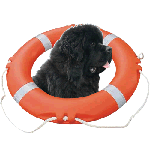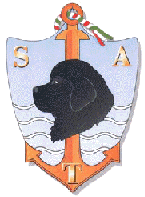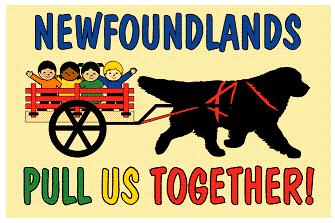Friday, April 24, 2009
For Gaia -- Ch Sadie Cymryd At Y Pen


You deserved so much more, and are so missed.
May the blessed Mary of the Angels wrap you in her cloak of peace.
When The Angels Fall
"So high above the world tonight
The angels watch us sleeping
And underneath a bridge of stars
We dream in safety’s keeping
But perhaps the dream
Is dreaming us
Soaring with the seagulls
Perhaps the dream
Is dreaming us
Astride the backs of eagles
When the angels fall
Shadows on the wall
In the thunder’s call
Something haunts us all
When the angels fall
Take your father’s cross
Gently from the wall
A shadow still remaining
See the churches fall
In mighty arcs of sound
And all that they’re containing
Yet all the ragged souls
Of all the ragged men
Looking for their lost homes
Shuffle to the ruins
From the leveled plain
To search among the tombstones
When the angels fall
Shadows on the wall
In the thunder’s call
Something haunts us all
When the angels fall
These are my feet
These are my hands
These are my children
And this is my demand
Bring down the angels
Cast them from my sight
I never want to see
A million suns at midnight
Your hands are empty
The streets are empty
You can’t control us
You can’t control us anymore
When the angels fall
When the angels fall"
Rest in peace, great one.
They can't control you anymore.
Tuesday, April 21, 2009
Newfoundlands - "The Softer Side Of Life"


Seeing A Softer Side Of Life
Ark Crisis Child Care Center Welcomes Furry Friends
By Lindsey Ziliak
Sunday, April 19, 2009
www.courierpress.com
"When Mobie and Zebie, two Newfoundland dogs, bound through the Ark Crisis Child Care Center, kids start squealing.
"'The kids can't wait for the visit'", said Nancy Gump, executive director of the center.
"Gump added that it provides a unique and exciting experience for the children.
In reality, though, the dogs get just as much out of it.
"'The boys love the kids', said Kat Shockley, Mobie and Zebie's owner. 'They love to have an audience.'
"During their most recent visit on Thursday, Shockley said, 'They showed off so bad.'
"The kids giggle as the dogs romp and play. Some of the more timid ones only will watch from the sidelines. Others want to get a closer look and actually pet the dogs and play with them.
"'This one little girl cracks me up', said Shockley.
"When Shockley brings in the dogs, she always starts by asking if there are any children who are afraid of them. 'When I walked in, one little girl raised her hand and said 'doggies,' and ran over to them', Shockley said with a laugh. 'That answered my question.'
"Gump said the dogs provide many spontaneous, teachable moments. They've taught the children about having respect for animals.
"Shockley said some of the children see the dogs playing rough and are, in turn, rough with the dogs. 'We tell them to be gentle and soft with the animals', Shockley said.
"And for Shockley, bringing the dogs to visit is all about softness. 'There's very little softness in peoples' lives anymore. It's very rigid and strict', Shockley said. The dogs, she said, bring a little softness to these children, give them someone soft to cuddle with.
"'Some of those little ones could be having a really bad day'", Shockley said.
Gump added, 'Some of our children are experiencing tumultuous times. We deal with a lot of stuff, and sometimes it's hard to shut the door on it.'
"The dogs, however, lighten the mood for the children at least for a little while. When the dogs leave, though, the children stay busy with artwork.
"Art is a big part of the program at Ark Crisis Child Care Center. Gump said the preschoolers get very animated with the glitter, paint and glue. 'They love it. They can get messy and get paint all over them, and that's OK,' Gump said.
"She said it's all about staying upbeat for the children.
"The Ark Crisis Child Care Center is the only state-licensed, emergency child care center in Indiana and one of 11 in the United States. The center offers free, temporary child care for children from the ages of six weeks to six years."
Monday, April 20, 2009
Tuesday, April 14, 2009
Debunking The Dominance Myth
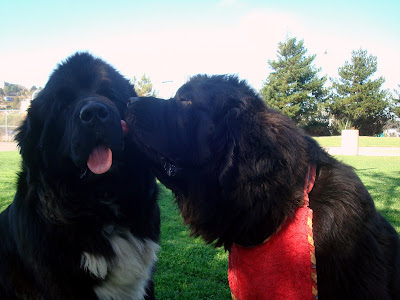
Debunking the Dominance MythShare
Are Dogs Lying Awake At Night Plotting A Coup?
By Carmen Buitrago, CPDT, CTC November 2004
"Have you ever wondered if your dog is dominant? Chances are you have, if only because over the last half century, every canine misbehavior from house soiling to door dashing has been deemed a “dominance” problem.
Your dog growls at visitors? Dominance, say well-meaning friends. He doesn’t always come when called? He’s telling you he’s boss, according to popular dog books. She pulls on leash or jumps up to greet you? She’s declaring alpha status. He prefers couches to floors? Watch out!
Perhaps the most unlikely behaviors heard attributed to dominance are coprophagia (stool eating) and fetching a ball.
How did dominance become one of the most popular and unthinking labels ever bandied about in dog circles?
A Catchy Concept
The concept of dominance — or “alpha,” meaning the highest ranked individual — originally came from some studies of wolf packs in the 1940s. The concept was catchy, and when it trickled down to popular dog culture, it took hold with the power of mythology. It quickly became “common knowledge” that domestic dogs are naturally dominant or will become so if their people tolerate certain behaviors. These dogs, it was claimed, will constantly challenge and test their owners until they are forcefully shown human leadership.
So-called dominance exercises were — and in some circles still are — widely recommended to prevent the dog from taking over the entire household. These exercises include not feeding him until after you’ve eaten, letting him through doorways only after you, forbidding access to furniture, and not playing tug-of-war.
In reality, there is no evidence that these procedures prevent dominance aggression or any other behavioral problem. One study found no correlation between playing tug-of-war or allowing a dog on the bed and the development of aggressive behavior.
Extreme Treatment
Beyond those exercises, many authors and trainers urged owners to hold or force their dogs into submissive positions, sometimes roughly, to the point of creating fearful responses. Today, some call these “gentling” exercises and recommend using them with puppies.
For example, you roll or flip your puppy on her back, and don’t let her up until she stops resisting. The claim is beguilingly simple: by forcing a dog to assume a submissive posture and then rewarding her for tolerating it, you teach her to submit to your leadership.
But notice the claim’s unspoken assumption that leadership is gained through force. In canine society, leadership is not won through brute physical domination. And a wide range of dogs with normal, sociable temperaments naturally will resist being forced on their backs, even to the point of defensive aggression.
Humans are not that different. Think how you would react if your boss established his or her “leadership” by physical force!
The technique has morphed further into a facile test of dominance. Force a dog on his back, and if he resists, he’s dominant! Instant (albeit wrong) diagnoses have wide appeal in homes, animal shelters, obedience schools, and even veterinary clinics.
Some so-called experts even suggest using violent techniques like scruff shakes and alpha rolls. At the extreme end, some trainers once advocated downright abusive methods, such as hanging a dog by a choke chain and leash (called helicoptering) until she passed out, or forcing her head underwater until she lost consciousness.
These tactics were considered treatment for behaviors as mild as digging or as serious as aggression.
Flaws Of The Wolf-Pack Studies
Unfortunately, our collective preoccupation with doggy dominance hasn’t served us or our dogs well. To begin with, it’s based on some outdated and flawed science as well as a fair amount of nonsense.
Dr. Ian Dunbar outlines three major flaws of the studies of wolf packs in the 1930s and 1940s. First, they were short-term and focused on the most obvious facet of wolf life, namely hunting. As a result, the studies gathered unrepresentative data and drew rather sweeping conclusions about wolf behavior (and later, dog behavior) based on about 1% of wolf life.
Second, the researchers observed what are now known to be ritualistic displays and misinterpreted them. The bulk of dominance mythology comes from these misinterpretations.
Take alpha rolls. The early researchers thought that the higher-ranking wolf forcibly rolled subordinate wolves to exert his dominance. Modern studies have shown that alpha rolls are part of an appeasement ritual offered voluntarily by the subordinate wolf, not forced by the superior.
A subordinate wolf offers his muzzle, and when the higher-ranking wolf “pins” it, the subordinate rolls over and presents his belly. There is no force. Canine behaviorist Jean Donaldson, author of the award-winning book The Culture Clash, says, “The truth is, there is not one documented case of a wolf forcefully rolling another wolf to the ground. Nor is there one case of a mother wolf (or dog) ‘scruff-shaking’ her puppies.”
A wolf would flip another wolf against its will only if he were planning to kill it. The same goes for a mother shaking her pup by the scruff. Both are rare events.
The third flaw was that the researchers made some wild extrapolations from their data. Their first leap of logic was applying their conclusions to dogs. Their second was applying them to human-canine interactions.
Dogs Aren’t Watered-Down Wolves
The fact is, dogs aren’t wolves. Wolves are dogs’ closest relatives — just as chimpanzees are ours — but dogs became a separate species possibly as long as 135,000years ago. Although dogs retain some characteristics of wolves and other canids, thousands of years of domestication, co-evolution with humans, and selective breeding have changed them profoundly.
Dunbar once said, “Saying ‘I want to interact with my dog better, so I’ll learn from the wolves’ makes about as much sense as saying ‘I want to improve my parenting — let’s see how the chimps do it.’”
Applying the wolf studies to human-canine interactions was nonsense, according to Dunbar. Despite the flimsy evidence, books and methods abounded, exhorting owners to be “leader of the pack.” They portrayed an adversarial human-canine relationship and advocated combative training methods that relied on force, punishment, and even pain. After all, force was thought to be necessary to put ambitious dogs in their place.
In her book Dog Friendly Dog Training, Andrea Arden writes, “Rather than teaching our best friends, we were advised to physically dominate our dog to bring him into line.”
In stark contrast to the popular myth of wolves (and dogs) ruling with an iron paw, however, wolves’ and dogs’ social structure is much more complex, flexible, and subtle.
Benevolent Leadership
Based on better and longer studies of canines, scientists have learned that the mark of a true leader is the ability to control without force, according to Dr. Myrna Milani, a veterinarian and behaviorist. She points out that, in the wild, animals who rule with brute force get eliminated from the gene pool, because force requires so much energy and puts the animals at high risk of death, injury, or predation.
Instead, the vast majority of alpha dogs lead benevolently. They do not stoop to physical domination to prove their points. They don’t need to. They lead through subtle psychological control, such as confident posture, withering glances, staring, stalking, dogging (persistently hassling), barking, or growling.
It’s all ritualistic. Day-to-day interactions are based largely on deferential and cooperative behaviors, and conflicts are settled by elaborate displays designed to inhibit aggression or turn off threats.
So despite popular myth, alpha does not mean physically dominant or most aggressive. It means in control of resources. A leader is one who has earned the right to control whatever resources he or she thinks are important. What’s important is flexible. It changes depending on the dog’s motivation, the context, and the situation at the moment. So an alpha dog might give up a prime sleeping place because he couldn’t care less, or relinquish a succulent bone because she’s lost interest.
Maintaining Order Through Submission
Another assumption of pack theory was that wolves, and therefore dogs, organized themselves in a fixed, linear dominance hierarchy — a chicken-like pecking order in which the dominant animals maintain order by threatening and intimidating underlings.
Now experts agree that wolves form an appeasement (also called subordinance) hierarchy, in which subordinate animals maintain order through active displays of submission and deference.
Donaldson offers the Army as a human analogy. Lower-ranking soldiers first salute their superiors with a flourish and then get a cursory salute in return. This is a classic appeasement hierarchy. A general doesn’t enter a room and throw his weight around. He simply appears and everyone starts saluting.
But going beyond observations of wolf behavior, modern researchers have studied the behavior of village, feral, and companion dogs to understand canine social structures better.
These scientists observed loose social structures that were flexible and unpredictable. The structures observed were determined more by factors like food availability and human intervention than by any innate sense of social hierarchy. These same experts now emphasize the importance of treating the domestic dog as the distinct species it is, not as a sort of watered-down wolf.
Problems With The Dominance Label
Another main flaw of dominance theory is the term itself. A cornerstone of science is precise, unambiguous definitions that facilitate communication. Ethological terms like dominance are not precise definitions but are constructs used to label and summarize a range of behaviors. One problem with constructs, psychologists Drs. Garry Martin and Joseph Pear point out, is that they lead to circular reasoning.
For example, a dog that growls when approached near her food bowl might be labeled dominant. Then if you ask the owner why the dog growls, she’ll answer, “Because she’s dominant.” So the label becomes a pseudoexplanation for the behavior.
The label also can affect the way the animal is treated. The dominance label has been used to justify punishing dogs, especially those that react defensively to force-based training methods. The label also tends to focus attention on problem behaviors rather than on teaching and rewarding good ones.
A related term, dominance aggression, is similarly problematic. What does it mean? There’s no scientific consensus on how to define it academically, much less on how to identify it in the real world.
In Pet Behavior Protocols, Dr. Suzanne Hetts, an applied animal behaviorist, writes, “Sometimes it’s very difficult to categorize aggression more specifically than offensive or defensive. The behavioral descriptions of when aggression occurs and the associated body postures often don’t fit well into any of the classification schemes in the scientific literature on aggression. In addition, dogs may display more than one type of aggression, which contributes to the difficulty in categorization.”
If behavior as obvious as aggression is so difficult to categorize, how accurate can it be to label subtle, everyday behavior as “dominant”? It’s a judgment that presumes to understand dogs’ motives when, in fact, we have no idea what they’re thinking. There are dozens of possible causes, functions, or motives for any problem behavior.
Moving Past The Label
In many aggression cases, the history and description of the dogs’ behavior are inconsistent with our traditional understanding of dominance. So-called dominant dogs often show ambivalent, fearful, and anxious body language. They may shake and act very submissively during and after a bite. Studies show that dogs displaying “dominance aggression” get less exercise, are more fearful of people, are more excitable, and react more to high-pitched noises. All this is inconsistent with our notion of the fearless, dominant dog and suggests other factors at play in aggressive behavior.
This new information challenges us to interpret the social relationship between dogs and owners in a more sophisticated way than as simplistic dominant-submissive relationships.
Fortunately, behavioral science and most dog trainers have moved past the flawed dominance label. A new term being used for dominance aggression is status-related aggression. Treatment focuses on teaching and rewarding the dog for desired behaviors, regardless of status. It also seeks to identify the many other possible causes of problem behaviors, such as fear or anxiety, insufficient socialization, boredom, lack of exercise, too little companionship, or lack of training.
How To Lead With Brains, Not Brawn
Far more dogs are unruly than status-seeking, according to Dr. Suzanne Hetts. No one taught them basic obedience. In the absence of structure and consistent rules, they’ve learned annoying, attention-getting behaviors. And some are pushy, like children who test their parents’ limits to see what behavior they can get away with.
The way to regain control over your unruly or pushy dog and create an enjoyable companion is through training. Positive, dog-friendly training opens a window of communication between two species that can’t talk to each other. In private or group classes, owners learn the basic ways that dogs learn. When they apply these “laws of learning” to their companions, dogs start cooperating, and everyone seems relieved and delighted to have discovered a common language.
Some Tips For Getting Started:
• Find a positive (no-force, reward-based) training class so the two of you can learn how to communicate.
• Memorize at least two basic laws of learning: 1) all animals (and young children) learn by the immediate — not delayed — consequences of their behavior, and 2) behaviors that meet with rewarding consequences will happen more often.
• Leverage valued resources like food, toys, play, walks, and petting. Don’t give them away for free. Use them as rewards for good behavior, like sit or down.
• Master the technique of giving resources for desirable behavior and withholding them for undesir-able behavior. It’s like teaching a toddler that a soft “please” gets her a cookie but a shouted “Gimme!” gets her nothing. In short, reward deferential, polite behaviors and ignore pushy ones.
• Learn to set your dog up for success and prevent mistakes. Your dog chews shoes? Don’t leave shoes lying around. Instead, introduce her to the joys of chewing on stuffed Kongs. Your dog potties in the house? Don’t let him run around unsupervised, and make sure you take him outside on a reliable schedule and reward him when he potties there. Your dog digs in the garden? Get her hooked on her own “legal” digging pit by burying tasty bones there. Once the good habit is set, you can interrupt mistakes and redirect her to her legal area."
Wednesday, April 8, 2009
Karazan Music Of The Night
Tuesday, April 7, 2009
The Newfoundland -- Water Rescue Dog
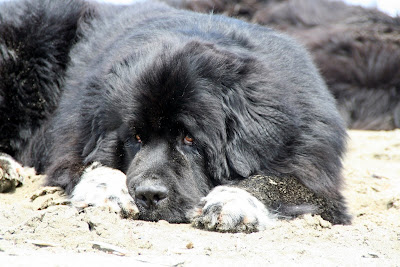

(Courtesy of The Colonial Newfoundland Club)
"The Newfoundland is exceptionally well built for water work. He has a water resistant double coat, a strong muscled tail which is used as a rudder, webbed feet, ears that cling close to the head, and a strong swimming style resembling a breast stroke.
"Newfoundlands are used to help patrol the beaches in Britain, France, and Italy. During their annual water training demonstration at the Molveno Dog Show, the Italian School of Dog Training showcases circumstances in which Newfs and their handlers jump out of helicopters hovering 15 feet above the water's surface. The French Coast Guard has determined that a well-conditioned Newf can tow an inflatable life raft with 20 people aboard two miles to shore with out being unduly stressed.
"The water rescue instincts of the Newf are particularly evident when children or other family members are in the water. The Newf takes his life guarding responsibilities very seriously, quite often circling around and herding his "family" to shore. They have an uncanny ability to sense when someone in the water needs help, whether a family member or stranger, an will immediately swim out to assist. Some dogs circle around the "victim" until they feel the person grab onto them, then head to shore; others will take the person's arm in their mouth and proceed to tow them to safety that way.
"The Newfoundland is primarily a dog of the sea. Long ago they were the constant companions of fishermen, and boats would often not leave the shore without a Newfoundland on board. History is full of old tales recording heroic rescues made by these courageous animals. Today, the breed standard stresses that the dog should be "at home in the water and on land." The Newf is exceptionally well built for water work. He has a water resistant double coat, a muscled tail which is used as a rudder, webbed feet, ears that cling close to the head, and a strong swimming style resembling a breast stroke.
Water Tests
"Great Britain first sponsored formal water tests for Newfoundlands in the late 1800's. The Newfoundland Club of American began its water tests in 1973, with the first test in this country being held by the Great Lakes Newfoundland Club in Michigan.
"The Water Test offers the Newfoundland an opportunity to perform a series of exercises designed to show their natural life-saving instincts. The test is composed of Junior and Senior Divisions. Each contains six exercises with suggested time limits. A dog successfully completing the Junior exercises is awarded the NCA title of Water Dog (WD). Successful completion of the Senior exercises earns a Water Rescue Dog (WRD) title.
"The Newfoundland Club of America encourages its members to foster and maintain the working dog abilities that are such an important part of the history of the breed. To this end, the NCA sponsors Water Tests across the country. The Newfoundland Club of America Water Tests are a series of exercises designed to develop and demonstrate the water work abilities of purebred Newfoundland dogs. The Newfoundland has historically functioned as a working companion to its owner, and members of the breed have participated in many heroic rescues. Performance of these exercises is intended as a demonstration of skill developed through both natural ability and training. The emphasis in the Water Test is on teamwork between dog and handler in realistic work and rescue situations."
* * * * * * * * * * *
Of course, there are exceptions -- the Hangashore being the most prominent.
Saturday, April 4, 2009
It's A Brand Newf Day

Brand Newf Day
How many of you people out there
Been hurt in some kind of love affair
And how many times do you swear that you'll never love again?
How many lonely, sleepless nights
How many lies, how many fights
And why would you want to put yourself through all that again?
"Love is pain," I hear you say
Love has a cruel and bitter way
Of paying you back for all the faith you ever had in your brain
How could it be that what you need the most
Can leave you feeling just like a ghost?
You never want to feel so sad and lost again
One day you could be looking
Through an old book in rainy weather
You see a picture of her smiling at you
When you were still together
You could be walking down the street
And who should you chance to meet
But that same old smile that you've been thinking of all day
You can turn the clock to zero, honey
I'll sell the stock, we'll spend all the money
We're starting up a Brand Newf day
Turn the clock all the way back
I wonder if she'll take me back
I'm thinking in a Brand Newf way
Turn the clock to zero, sister
You'll never know how much I missed her
Starting up a Brand Newf day
Turn the clock to zero, boss
The river's wide, we'll swim across
Started up a Brand Newf day
It could happen to you - just like it happened to me
There's simply no immunity - there's no guarantee
I say love's such a force - if you find yourself in it
And sometimes no reflection is there
Baby wait a minute, wait a minute
Wait a minute, wait a minute
Wait a minute, wait a minute
Turn the clock to zero, honey
I'll sell the stock, we'll spend all the money
We're starting up a Brand Newf day
Turn the clock to zero, Mac
I'm begging her to take me back
I'm thinking in a Brand Newf way
Turn the clock to zero, boss
The river's wide, we'll swim across
Started up a Brand Newf day
Turn the clock to zero buddy
Don't wanna be no fuddy duddy
Started up a Brand Newf day
I'm the rhythm in your tune
I'm the sun and you're the moon
I'm a bat and you're the cave
You're the beach and I'm the wave
I’m the plow and you’re the land
You're the glove and I'm the hand
I'm the train and you're the station
I'm a flagpole to your nation - yeah
Stand up all you lovers in the world
Stand up and be counted every boy and every girl
Stand up all you lovers in the world
Starting up a Brand Newf day
I'm the present to your future
You're the wound and I’m the suture
You're the magnet to my pole
I'm the devil in your soul
You're the pupil I'm the teacher
You're the church and I'm the preacher
You're the flower I'm the rain
You're the tunnel I'm the train
Stand up all you lovers in the world
Stand up and be counted every boy and every girl
Stand up all you lovers in the world
Starting up a Brand Newf day
You're the crop to my rotation
You're the sum of my equation
I'm the answer to your question
If you follow my suggestion
We can turn this ship around
We'll go up instead of down
You're the pan and I'm the handle
You're the flame and I'm the candle
Stand up all you lovers in the world
Stand up and be counted every boy and every girl
Stand up all you lovers in the world
We're starting up a Brand Newf day.
Brand-Newf - - You just can't top it.
Friday, April 3, 2009
Wednesday, April 1, 2009
What Really Happens At Dog Shows
The teeming underbelly of the dog show world is caught by 60 Minutes. Pippa, such a sweet girl.
Subscribe to:
Posts (Atom)


